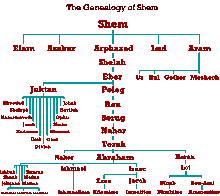Ishmaelites

The Ismaelites or Ismaelites (Latin Ismaelitae , English Ishmaelites ) are the descendants of Abraham's firstborn son Ismael , who is considered the progenitor of the Arabs . In the Christian Orient this term was used as a name for Muslims from the early Middle Ages . For example, in the Apocalypse of Pseudo-Methodius , which was written in the late 7th century, the Muslim Arabs are described as "sons of Ishmael". In the 8th century the theologian John of Damascus (d. 754) wrote a pamphlet against the "heresy of the Ishmaelites", by which he meant Islam . In the Coptic Daniel book, which is dated to the middle of the 8th century, the Umayyad state is described as the "empire of the Ishmaelites" and integrated into the doctrine of the four kingdoms .
In Eastern Europe , especially in Kievan Rus , the Ishmaelites were those Turkic-speaking Muslims who traded from the lower Volga and the northern edge of the Caspian Sea in the eastern countries of Europe and later settled there. The Nestor Chronicle explains that there are a total of four Ishmaelite tribes, namely the Turkmen , the Pechenegs , the Turks and the Polovz or Cumans. The term was also used in this sense in medieval Hungary. In the 58th chapter of the Gesta Hungarorum it is reported that in the 10th century a large number of Ishmaelites from Bolgar came to Hungary. This refers to Cumans who immigrated from the Volga Bulgarian Empire and formed the earliest Muslim population in Hungary .
In the Latin West, the term Ishmaelites - along with Saracens - was generally used as a term for Muslims. The Spanish theologian Juan de Torquemada (d. 1468) wrote a Tractatus contra Madianitas et Ismaelitas .
The Ishmaelites are not to be confused with the Ismailis , the followers of a Shiite doctrine. These are named after Ismāʿīl ibn Jafar , the son of the sixth Shiite imam , Jafar as-Sādiq .
literature
- Carl Heinrich Becker : "The Empire of the Ishmaelites in the Coptic Daniel Book" in news from the Royal Society of Sciences in Göttingen. Philological-historical class (1916) 7-57. Digitized
- Leonid Chekin: "The Godless Ishmaelites: the Image of the Steppe in Eleventh-Thirteenth-Century Rus'" in Russian History 19 (1992) 9-28.
- Alexius Csetneky: "The Ishmaelites in Hungary" in Hungarian Review 1 (1881) 658-675. PDF
- Clemens Gantner: “Hope in the Apocalypse? The Ishmaelites in the older Latin versions of the Revelationes of Pseudo-Methodius ”in Veronika Wieser u. a. (Ed.): Western apocalyptic. End times genealogy compendium. Akademie-Verlag, Berlin, 2013. pp. 521–546.
- Ernst Axel Knauf : Ismael: Investigations into the history of Palestine and North Arabia in the 1st millennium BC Chr. Harrassowitz, Wiesbaden, 1985.
- Daniel Sahas: John of Damascus on Islam: The "Heresy of the Ishmaelites." Brill, Leiden, 1992.
- Stefan Schreiner: "The" heresy of the Ishmaelites ": Islam as a political and theological problem of Christians and Jews and the beginnings of Christian and Jewish anti-Islamic polemics." In Hansjörg Schmid u. a. (Ed.): Identity through difference? Mutual delimitations in Christianity and Islam. Pustet, Regensburg, 2007. pp. 132-137. - Reprinted in Stefan Schreiner: The Jewish Bible in an Islamic interpretation . Mohr Siebeck, Tübingen, 2012. pp. 323–343.
- Alois Sprenger: "The Ishmaelites, and the Arabic Tribes Who Conquered Their Country." in The Journal of the Royal Asiatic Society of Great Britain and Ireland 6 (1873) 1-19.
- John Victor Tolan: “'A wild man, whose hand will be against all': Saracens and Ishmaelites in Latin Ethnographical Traditions, from Jerome to Bede” in Walter Pohl u. a. (Ed.): Visions of community in the post-Roman world: the West, Byzantium and the Islamic world, 300-1100 Ashgate, Farnham, 2012. pp. 513-530.